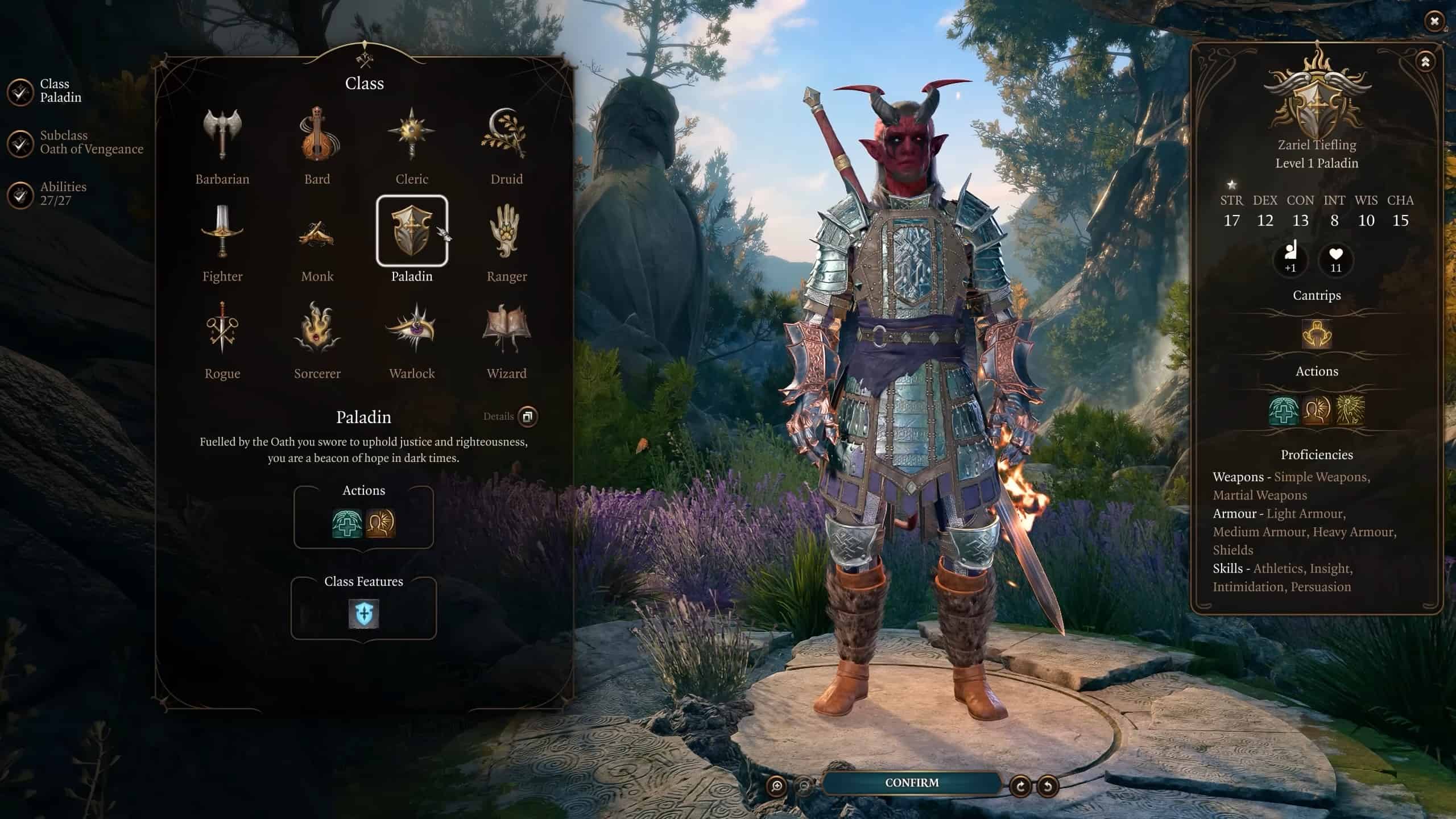The Paladin in Baldur’s Gate 3 is a virtuous combatant who is armed to the teeth with weaponry and holy magic and comes to the defense of the defenseless. They are a beacon of hope in the darkest of times. While the Paladin is primarily a support class, they can easily take up the role of being a leader as well. Paladins are effectively a cross between a Cleric and a Fighter and they reflect that in their stats, abilities, and more.
The paladin class is also able to wield every armor class in the game and all simple and martial weapons. Paladins in Bg3 are bound by oath to their diety and live their lives according to their tenants. They must follow them at all times otherwise they’ll break their oaths and lose their deity’s favor.
Paladin Hit Points
The paladin class features a hit die of 1d10 which means that the max health you can role for is 10 making them a durable class. At level 1, the paladin starts out with 10 hit points plus the bonus provided by the constitution modifier. At each subsequent level up, you gain an additional six hit points per level up, plus the bonus from the constitution modifier.
Class Actions
The Paladin Class in Baldur’s Gate 3 features three standard Class Actions. These Class Actions are available to all subclasses. Each subclass may get additional unique actions of its own when you choose one.
Channel Oath Charges
As a Paladin, you are able to channel the power granted to you by your Paladin oath. The charge can be applied to cast a number of abilities, actions, and skills. Oath Charges allow you to improve your proficiencies as well as your saving throws.
Lay on Hands
This is an action that allows you to heal any creature or player, including yourself, that you can touch. Furthermore, this action also allows you to rid your target of any poisons or debuffs. This action applies 4 healing. It is important to note that this action does not work on the undead or constructs.
Divine Sense
This action gives you an advantage on attack rolls against a few enemy types, namely; celestials, undead, and fiends.
Fighting Style
Like the Fighter, the Paladin can choose a fighting style that depends on what role you want to perform in the party in Baldur’s Gate 3. Once you hit level 2 you can start branching off and build a character that fits your playstyle.
Defense: Going down the Defense route nets your character a +1 bonus to their armor class.
Dueling: When you choose the Dueling Fight Style, you are granted +2 bonus to your attack rolls as long as you’re holding a weapon in one hand and your off-hand has no weapons.
Great Weapon Fighting: By going down this route you can reroll 1s and 2s on your damage die when attacking with a two-handed weapon.
Proficiencies
The Paladin is an all-around very versatile class, having proficiencies in a number of equipment and armaments. When you use this class, expect to wield a large variety of gear. In the case of armor, the Paladin class is able to effectively use all types of armor along with shields.
As far as weapons are concerned, this class can wield both simple and martial weapons, just like the Fighter class. The Paladin class has two saving throws in the Charisma and Strength skills.
Paladin Subclasses
The Paladin class can specialize in a total of four subclasses. Three standard and one hidden. The three standard subclasses are available right off the bat. However, the fourth one requires a bit of work. Each subclass features a unique action but by in large they are all fairly the same.
Oath of Vengeance
Oath of Vengeance subclass and its build grants access to the class-specific “Inquisitors Might” action. This action lets the Paladin class cast a spell that allows them or their party member to daze enemies for one turn. Additionally, this action also makes the affected character take two radiant damage to their enemies for 1 turn. The radiant damage dealt depends on your character’s charisma points.
Oath of the Ancients
This subclass gives you access to the “Healing Radiance” action which allows you to heal yourself and those around you within a 3-meter range. However, it does not have an effect on constructs or the undead classes.
Oath of Devotion
This Subclass allows you to use the “Holy Rebuke” action. Holy Rebuke lets the Paladin class imbue one of their party members with an aura that deals damage to anyone who attacks. This is only effective if the attacker attacks them with a melee weapon. The damage dealt is 1d4 and is useful within a range of 18 meters.
Oathbreaker
To become Oathbreaker Paladin, you’ll need to break the oath of one of three subclasses, after which an Oathbreaker Knight will approach you. Here, you’ll have the option to either retake your oath or continue as an Oathbreaker.
The Oathbreaker subclass action allows the paladin class to cast a spell called “Spiteful Suffering” that damages the target with necrotic damage. This effect lasts for a total of three turns and is capped at 1d4 damage. Additionally, attacking your opponent while they are under the influence of this spell, nets you additional advantages.
